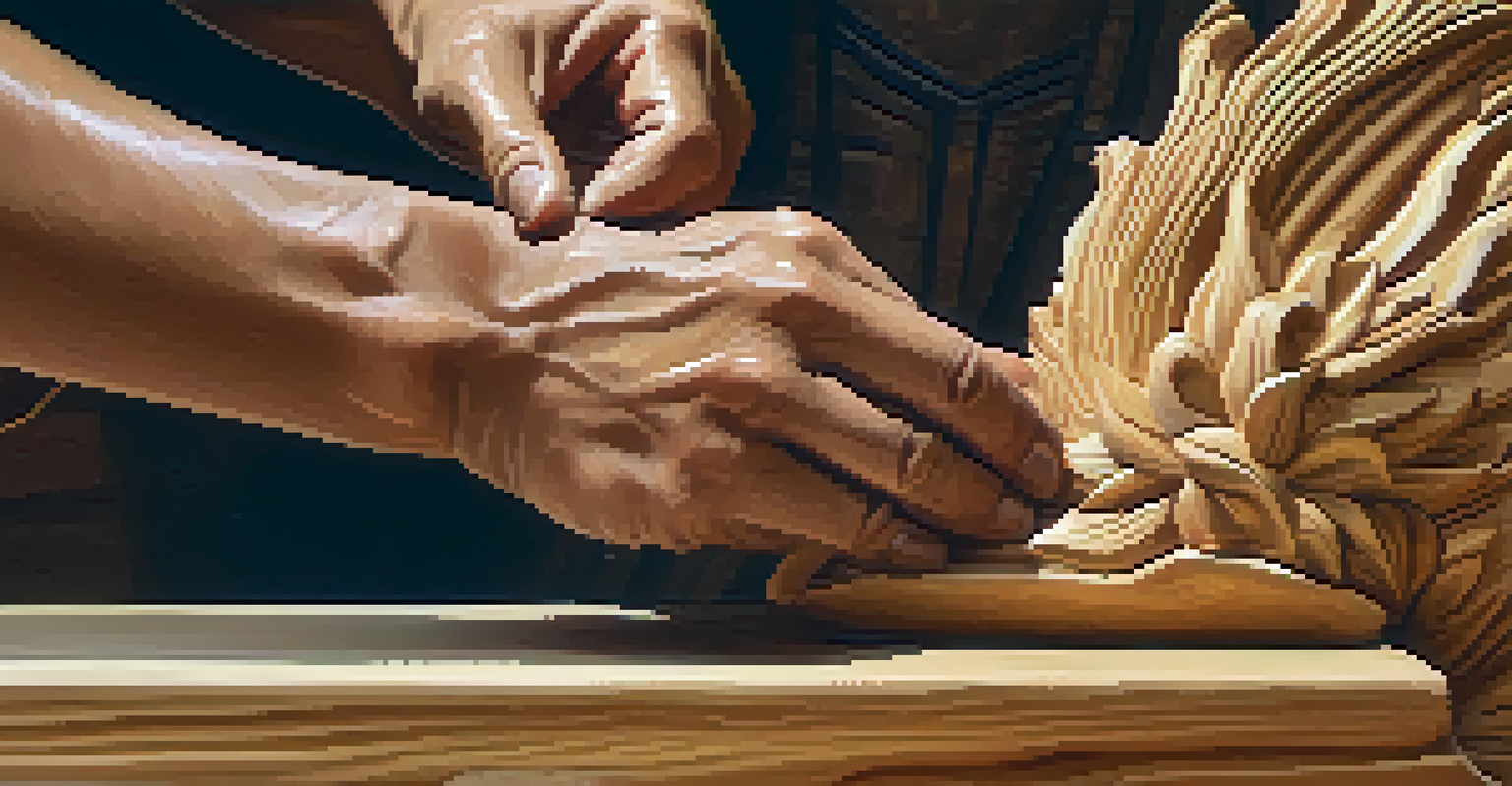Evaluating the Carbon Footprint of Wood Carving Practices

Understanding Carbon Footprint in Wood Carving
The carbon footprint of wood carving refers to the total greenhouse gas emissions associated with the practice. This includes everything from the sourcing of wood to the tools and techniques used by artisans. By understanding this concept, we can begin to evaluate how sustainable our carving practices really are.
The greatest threat to our planet is the belief that someone else will save it.
Every step in the wood carving process can contribute to carbon emissions, including the energy consumed during carving and the transportation of materials. For instance, using electric tools might seem efficient, but the source of the electricity plays a crucial role in determining the overall carbon footprint. It’s essential to consider these factors holistically.
Ultimately, evaluating the carbon footprint is not just a checkbox activity; it’s about fostering a deeper appreciation for our craft and how it interacts with the environment. By taking a closer look, we can identify areas where we might reduce emissions and make more eco-friendly choices.
Selecting Sustainable Wood for Carving
Choosing the right type of wood can significantly impact the carbon footprint of your carving practice. Sustainable wood sources, such as those certified by the Forest Stewardship Council (FSC), ensure that the wood is harvested responsibly. This means that the trees are cut down in a way that does not harm the forest’s ecosystem.

For example, using reclaimed wood not only reduces the need for new timber but also gives a second life to materials that might otherwise be discarded. This practice not only minimizes carbon emissions associated with logging but also adds a unique character to each piece you create. It's a win-win for both the environment and your art.
Understanding Carbon Footprint
Evaluating the carbon footprint in wood carving involves assessing emissions from sourcing materials to energy consumption during the crafting process.
By making informed choices about the wood you use, you can significantly lower the carbon footprint of your projects. Engaging with local suppliers who prioritize sustainability can also help reduce transportation emissions, further enhancing the eco-friendliness of your work.
Eco-Friendly Tools and Techniques in Wood Carving
The tools you use for wood carving can also influence your carbon footprint. Opting for hand tools instead of electric ones can drastically lower energy consumption during the carving process. While it might require more effort, the satisfaction and connection to the craft can be immensely rewarding.
We won’t have a society if we destroy the environment.
Additionally, when using power tools, consider those that are energy-efficient or powered by renewable energy sources. Some manufacturers are continually innovating to create tools that produce less waste and consume less energy. Choosing these can help you carve with a lighter environmental impact.
Incorporating traditional techniques, such as green woodworking, can further minimize your carbon footprint. This method utilizes freshly cut wood that can be shaped while still pliable, reducing the need for energy-intensive processes and allowing for a more natural crafting experience.
The Role of Finishes and Treatments in Sustainability
Finishing products are essential in wood carving, but they can also contribute to your carbon footprint. Many conventional finishes contain harmful chemicals that not only impact the environment but can also pose health risks. Opting for natural, eco-friendly finishes can mitigate these concerns.
For example, plant-based oils and waxes not only enhance the beauty of your carvings but also have a lower environmental impact compared to synthetic options. These natural treatments often require less energy to produce and can be biodegradable, making them a more sustainable choice.
Choosing Sustainable Wood
Selecting sustainable wood sources, like reclaimed or FSC-certified options, can significantly lower the carbon footprint of your carving projects.
By selecting finishes that align with sustainable practices, you’re not just enhancing your work’s longevity; you’re also making a statement about your commitment to the environment. Every small choice adds up, contributing to a more sustainable wood carving culture.
Assessing Transportation and Supply Chain Emissions
Transportation carries a significant portion of the carbon footprint in wood carving practices. From shipping raw materials to delivering finished products, the logistics involved can greatly impact overall emissions. Understanding your supply chain is crucial for finding opportunities to reduce this footprint.
For instance, sourcing materials locally not only supports your community but also minimizes transportation emissions. When you can, choose suppliers who are nearby to cut down on the distance your materials must travel. This small change can lead to a more sustainable practice overall.
Additionally, considering the packaging used for shipping can also play a role in sustainability. Opting for minimal, recyclable packaging can reduce waste and pollution associated with your materials, further contributing to a lower carbon footprint.
Community Involvement and Sustainable Practices
Being part of a community can enhance your understanding of sustainable wood carving practices. Engaging with other artisans who prioritize eco-friendly techniques can provide valuable insights and foster a culture of sustainability. Sharing experiences and challenges can inspire innovative solutions.
Participating in workshops or discussions focused on sustainable practices can also elevate your own craftsmanship. Learning from experts and exchanging ideas can help you discover new methods or materials that align with your environmental goals. It’s about collective growth and accountability.
Community and Sustainable Practices
Engaging with a community of artisans focused on eco-friendly techniques fosters innovation and encourages broader sustainable practices in wood carving.
Moreover, advocating for sustainable practices within your community can lead to broader changes. By encouraging others to consider their carbon footprint, you contribute to a larger movement towards a more responsible approach to wood carving, ultimately benefiting the planet.
Measuring and Reducing Your Carbon Footprint
Once you have a grasp on the factors affecting your carbon footprint, the next step is measurement. Various tools and calculators are available to help you estimate your emissions from different practices. This data can provide a baseline to identify areas for improvement.
After assessing your footprint, consider implementing strategies to reduce it. This could involve setting specific goals, such as using a certain percentage of reclaimed wood or reducing energy consumption by a set amount. Small, achievable targets can lead to significant changes over time.

Accountability is key in this process. Regularly revisiting your carbon footprint and adjusting your practices accordingly can help you stay committed to sustainable wood carving. The journey toward sustainability is ongoing, and every step counts.